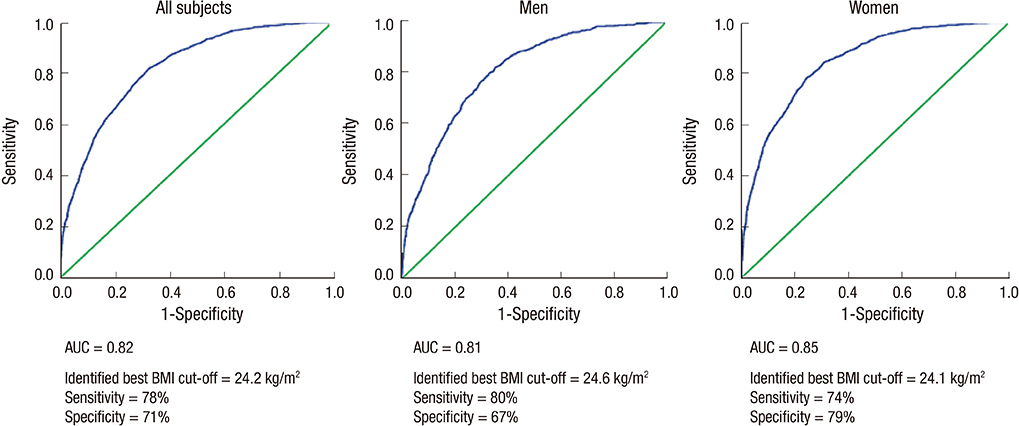J Korean Med Sci.
2015 Feb;30(2):162-166. 10.3346/jkms.2015.30.2.162.
Diagnostic Performance of Body Mass Index Using the Western Pacific Regional Office of World Health Organization Reference Standards for Body Fat Percentage
- Affiliations
-
- 1Department of Family Medicine, Hallym University College of Medicine, Chuncheon, Korea. fmjjcho@naver.com
- 2Sejong Samsung Med Clinic, Kangbuk Samsung Hospital, Sejong, Korea.
- KMID: 2129646
- DOI: http://doi.org/10.3346/jkms.2015.30.2.162
Abstract
- Associations between body mass index (BMI), body fat percentage (BF%), and health risks differ between Asian and European populations. BMI is commonly used to diagnose obesity; however, its accuracy in detecting adiposity in Koreans is unknown. The present cross-sectional study aimed at assessing the accuracy of BMI in determining BF%-defined obesity in 6,017 subjects (age 20-69 yr, 43.6% men) from the 2009 Korean National Health and Nutrition Examination Survey. We assessed the diagnostic performance of BMI using the Western Pacific Regional Office of World Health Organization reference standard for BF%-defined obesity by sex and age and identified the optimal BMI cut-off for BF%-defined obesity using receiver operating characteristic curve analysis. BMI-defined obesity (> or =25 kg/m2) was observed in 38.7% of men and 28.1% of women, with a high specificity (89%, men; 84%, women) but poor sensitivity (56%, men; 72% women) for BF%-defined obesity (25.2%, men; 31.1%, women). The optimal BMI cut-off (24.2 kg/m2) had 78% sensitivity and 71% specificity. BMI demonstrated limited diagnostic accuracy for adiposity in Korea. There was a -1.3 kg/m2 difference in optimal BMI cut-offs between Korea and America, smaller than the 5-unit difference between the Western Pacific Regional Office and global World Health Organization obesity criteria.
Keyword
MeSH Terms
Figure
Cited by 1 articles
-
Correlation between obesity and pelvic organ prolapse in Korean women
Bo Hye Kim, Soo Bin Lee, Eun Duc Na, Hyeon Chul Kim
Obstet Gynecol Sci. 2020;63(6):719-725. doi: 10.5468/ogs.19075.
Reference
-
1. Pi-Sunyer FX. The obesity epidemic: pathophysiology and consequences of obesity. Obes Res. 2002; 10:Suppl 2. 97s–104s.2. Korea Institute for Health and Social Affairs. Report of national health and nutrition survey 1998. Seoul: Korea Institute for Health and Social Affairs;1999.3. WHO Expert Consultation. Appropriate body-mass index for Asian populations and its implications for policy and intervention strategies. Lancet. 2004; 363:157–163.4. World Health Organization. The Asia-Pacific perspective: redefining obesity and its treatment. Geneva: World Health Organization Western Pacific Regional Office;2000.5. Deurenberg P, Yap M, van Staveren WA. Body mass index and percent body fat: a meta analysis among different ethnic groups. Int J Obes Relat Metab Disord. 1998; 22:1164–1171.6. Physical status: the use and interpretation of anthropometry. Report of a WHO Expert Committee. World Health Organ Tech Rep Ser. 1995; 854:1–452.7. Romero-Corral A, Somers VK, Sierra-Johnson J, Thomas RJ, Collazo-Clavell ML, Korinek J, Allison TG, Batsis JA, Sert-Kuniyoshi FH, Lopez-Jimenez F. Accuracy of body mass index in diagnosing obesity in the adult general population. Int J Obes (Lond). 2008; 32:959–966.8. Zheng W, McLerran DF, Rolland B, Zhang X, Inoue M, Matsuo K, He J, Gupta PC, Ramadas K, Tsugane S, et al. Association between body-mass index and risk of death in more than 1 million Asians. N Engl J Med. 2011; 364:719–729.9. Jee SH, Sull JW, Park J, Lee SY, Ohrr H, Guallar E, Samet JM. Body-mass index and mortality in Korean men and women. N Engl J Med. 2006; 355:779–787.10. Foley JT, Lloyd M, Temple VA. Body mass index trends among adult U.S. Special Olympians, 2005-2010. Adapt Phys Activ Q. 2013; 30:373–386.11. Cho YG, Kang JH, Kim KA. Comparison of bioelectrical impedance analysis with dual energy X-ray absorptiometry in obese women. Korean J Obes. 2007; 16:50–57.12. Schoeller DA, Tylavsky FA, Baer DJ, Chumlea WC, Earthman CP, Fuerst T, Harris TB, Heymsfield SB, Horlick M, Lohman TG, et al. QDR 4500A dual-energy X-ray absorptiometer underestimates fat mass in comparison with criterion methods in adults. Am J Clin Nutr. 2005; 81:1018–1025.13. Rothney MP, Brychta RJ, Schaefer EV, Chen KY, Skarulis MC. Body composition measured by dual-energy X-ray absorptiometry half-body scans in obese adults. Obesity (Silver Spring). 2009; 17:1281–1286.
- Full Text Links
- Actions
-
Cited
- CITED
-
- Close
- Share
- Similar articles
-
- WHO Western Pacific Regional Action Plan for the Prevention and Control of NCDs (2014-2020)
- Age Associated Changes in Body Mass Index and Body Fat Distribution
- Analysis of Body Fat Mass Index for Korean Adults
- Towards the Sustainable Development Goals: implications for health systems in the Western Pacific
- Body mass index and body composition scaling to height in children and adolescent


